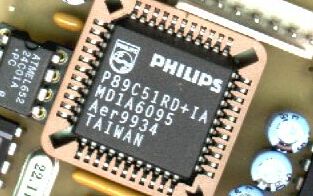 US SITE · AUS SITE
US SITE · AUS SITE
 CONTACT or ENQUIRY
CONTACT or ENQUIRY
©2010 AirBorn
|
Serially programmed 8051 FLASH micro's
If you haven't come across them already, we'd like to introduce our
favourite chips - FLASH 8051 microprocessors - now made by a range of
different manufacturers - and specifically we'd like to tell you about the
Philips P89LPC932, the Philips P89C51RD+ and Temic T89C51RD2.
 When it comes to the types of microprocessor to use in a project,
there are as many best choices as there are design engineers.
But some things just make good sense - and serially programmed
flash microcontrollers are one of them. When the main program
code can be downloaded to the target board through a serial
port, the whole manufacturing process becomes a lot easier.
When that code is also in flash memory, so that it can be updated
without chip replacement when the inevitable new program version
is required, field support is also a lot easier.
When it comes to the types of microprocessor to use in a project,
there are as many best choices as there are design engineers.
But some things just make good sense - and serially programmed
flash microcontrollers are one of them. When the main program
code can be downloaded to the target board through a serial
port, the whole manufacturing process becomes a lot easier.
When that code is also in flash memory, so that it can be updated
without chip replacement when the inevitable new program version
is required, field support is also a lot easier.
A lot of engineers have been making serially programmed FLASH program memory
products for years - the difference here is that there is no requirement for a separate
FLASH memory chip - the memory is within the microcontroller. Frequently there may
be an external signal of some type required to prevent erroneous programming.
Flash microcontrollers still have one downside - they tend to use more
power than one time programmable, EPROM or ROM memory microcontrollers.
But that is becoming less and less of an issue, with, for example, the Philips P89LPC932
microcontroller now powering down to idle at a typical 3.25ma at 3.6V supply.
The Philips P89LPC932:
- 28 pin TSSOP - 25 useable I/O pins, all in a 9mm x 7mm PCB area!
- Great Price (we can't quote - but about $2 US in 1000+ pcs)
- 8kbytes FLASH, 512 bytes EEPROM, and 768 bytes RAM
- On board +/- 2% accuracy oscillator - you can omit the Crystal
- Runs 6x normal 8051 speed; Standard 7.37Mhz, Crystal to 12Mhz
- On board Low Voltage Reset/Watchdog
- Runs 2.4 - 3.6V - but actually 2.7 - 3.6V with brownout detect
- 20ma output drive, schmitt inputs, comparator inputs, 5v tolerant I/O
- UART, SPI, I2C, 2xDPTR, Capture/Compare, Versatile clocks.
We have no "axe to grind" here - we are not associated with Philips in any way,
- other than as a customer. We do offer design services for clients wishing to use
the P89LPC family of devices, in new designs - circuitry, firmware and prototyping.
Please contact us
for a quote if you need this type of design support.
This page had a Maintenance update: 21 April 2013
 Overview Overview
 Continue Continue
|
 When it comes to the types of microprocessor to use in a project,
there are as many best choices as there are design engineers.
But some things just make good sense - and serially programmed
flash microcontrollers are one of them. When the main program
code can be downloaded to the target board through a serial
port, the whole manufacturing process becomes a lot easier.
When that code is also in flash memory, so that it can be updated
without chip replacement when the inevitable new program version
is required, field support is also a lot easier.
When it comes to the types of microprocessor to use in a project,
there are as many best choices as there are design engineers.
But some things just make good sense - and serially programmed
flash microcontrollers are one of them. When the main program
code can be downloaded to the target board through a serial
port, the whole manufacturing process becomes a lot easier.
When that code is also in flash memory, so that it can be updated
without chip replacement when the inevitable new program version
is required, field support is also a lot easier.